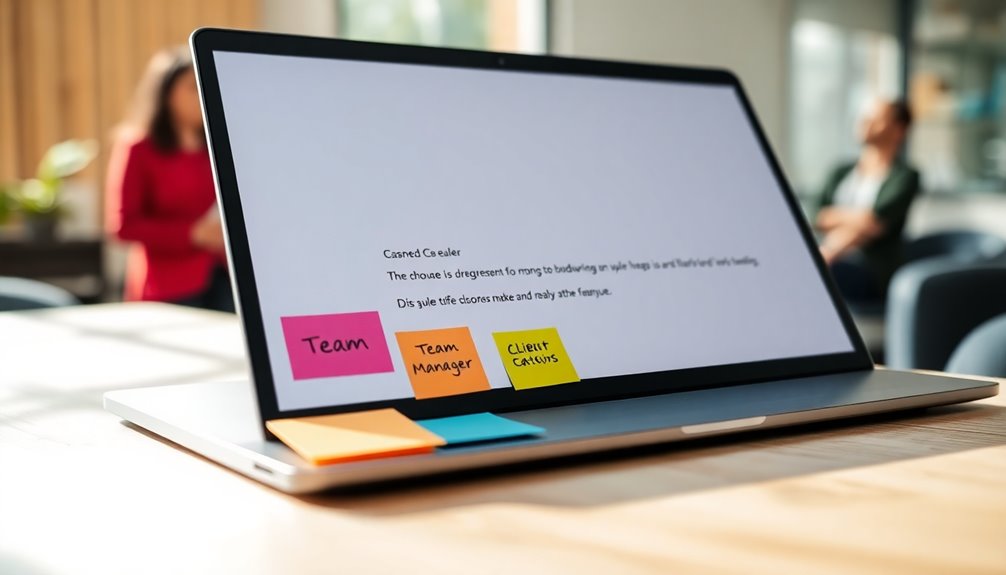To write CC in an email without confusion, focus on including only relevant recipients. Limit your CC list to stakeholders who benefit from the information but aren't required to act. Clearly define each person's role so everyone understands their purpose in the conversation. Avoid clutter by keeping your list concise, which helps maintain clarity and respect for recipients' time. Remember, CC is for transparency, while BCC serves confidentiality. To ensure you're using these strategies effectively, consider exploring additional tips that can enhance your email skills and streamline communication efforts further.
Key Takeaways
- Only include recipients in the CC field who are relevant to the discussion to avoid unnecessary confusion.
- Clearly define the role of each CC recipient to set expectations and enhance communication clarity.
- Limit CC usage to individuals not required to take action, reducing email clutter for better focus.
- Regularly review your CC practices to ensure they align with current team dynamics and communication needs.
- Educate team members on the distinction between CC and BCC to maintain transparency and trust in communications.
Introduction

When you send an email, knowing how to effectively use the CC (carbon copy) field can enhance your communication. The CC field is designed for email recipients who should stay informed without needing to take direct action. However, including too many recipients can lead to unnecessary emails and overwhelm everyone's inbox.
It's vital to limit CC usage to relevant stakeholders to maintain clarity in your email correspondence. In professional emails, the CC field promotes transparency, as all recipients can see each other's email addresses.
But be wary; this visibility can clutter inboxes if overused. Each person you CC should find the email content relevant to their role, ensuring effective communication and preventing information overload.
Before hitting send, double-check your CC list. This simple step helps ensure you're not including anyone unnecessarily, keeping the email streamlined.
Enhances Group Communication Clarity

Utilizing the CC field effectively can significantly enhance group communication clarity. When you CC recipients, you keep everyone informed without expecting them to take direct action. This approach fosters collaboration and transparency within your team. A well-structured CC list ensures that only relevant stakeholders receive the email, helping to prevent confusion and information overload. Consider the roles of each recipient before you hit send. Including unnecessary parties can clutter their inboxes and dilute the impact of your message. By carefully selecting your CC recipients, you can maintain focus and clarity in emails, ensuring that everyone understands the context and decisions being made. Regularly reviewing your CC practices is essential. It helps you adapt to changing team dynamics and improve overall group communication. Additionally, data-driven marketing can provide insights into effective communication strategies that resonate with your team.
Furthermore, differentiating between the CC and BCC fields can further streamline the communication process. Use CC for those who should stay in the loop, while reserving BCC for recipients who need to be discreetly informed. Furthermore, understanding the importance of networking opportunities can enhance collaboration and lead to improved communication strategies within your team.
Clear Recipient Visibility Guidelines

Often, clarity in recipient visibility is crucial for effective email communication. When you CC people, make sure to include only those who are relevant and necessary for the conversation. This practice not only keeps everyone informed but also prevents information overload.
Remember, recipients in the CC field can see each other's email addresses, which promotes transparency but requires you to consider the sensitivity of the information being shared.
Limit your CC usage to individuals who need to be informed but aren't expected to take action. Excessive CCing can clutter inboxes and lead to confusion, making it harder for recipients to focus on urgent tasks.
Clearly define the roles of each recipient in your email. This way, everyone knows who's expected to take action and who's simply being updated.
Regularly review your email etiquette practices to ensure you're using the CC field appropriately. This will enhance communication and ensure that all parties understand their roles within the conversation.
Step-by-Step CC Usage Guide

To effectively use the CC field in your emails, start by identifying who should be included. Only add recipients who are relevant to the conversation but don't need to take action. This keeps them informed without overwhelming their inbox.
When you send an email, address the primary recipient in the "To" field, ensuring clarity in your communication.
Next, make sure to clearly state why you're using CC in the email body. This helps all recipients understand their role in the conversation. Limit the number of CC recipients to those who truly need a copy of an email to avoid clutter and confusion about who should respond.
Using CC promotes transparency and collaboration, especially when keeping team members updated on project developments or involving stakeholders in important discussions.
Regularly review your CC practices to ensure they align with email etiquette and enhance communication effectiveness. By being mindful of who you include, you can make your emails more effective and maintain a clear line of communication.
Dos and Don'ts for CC Usage

Including the right people in the CC field can significantly impact your email's effectiveness. When using CC, make sure to include relevant stakeholders who need to be informed about the conversation. This promotes transparency and collaboration, ensuring all parties understand the context.
Limit your CC recipients to those essential for the discussion, as this maintains clarity and focus within the email thread. On the flip side, don't overuse the CC field by adding individuals who don't require the information. Doing so can clutter inboxes and lead to unnecessary email chains, causing important messages to be overlooked.
Remember, just because someone's in the CC doesn't mean they'll engage; their inclusion should always be justified by their relevance to the subject matter. Before CCing someone, consider the context and purpose of your email. This thoughtfulness helps streamline communication and ensures only those who'll truly benefit from the information remain in the loop. Additionally, being mindful of email etiquette can enhance professional relationships and foster effective communication.
Examples of CC Scenarios

When you're navigating email communication, knowing when to CC can make a big difference. For instance, when you're sending a project update, it's helpful to CC your manager. This way, you keep them informed of progress without needing their direct action.
In a leave request email, CC your job share partner. This ensures they're aware of your absence and can plan accordingly.
When making arrangements for a client meeting, consider CCing relevant team members. This facilitates coordination and ensures everyone's on the same page.
If you're sharing a critical policy update, CC department heads to maintain transparency and keep them informed of changes impacting their teams.
Lastly, when sending out a group email about a company event, CC the HR team. This keeps them in the loop about communications sent to employees.
Each of these scenarios demonstrates how strategic CC usage can enhance communication, ensuring all recipients are informed and engaged. By using CC effectively in your business emails, you can streamline processes and foster collaboration among your email account contacts.
Pro Tips for Writing Effective Emails

Crafting effective emails is essential for clear communication in any professional setting, especially as you juggle various stakeholders.
When you're sending an email, be mindful of your CC and BCC choices. CC means "carbon copy," allowing multiple people to see each other's email addresses, while BCC means "blind carbon copy," so recipients won't see who else is included. Use BCC when you want to keep your email list private.
To keep everyone informed about a conversation, clearly state the email's purpose in the body. This helps CC recipients understand why they're included and what's relevant to them.
Always limit the number of CC recipients to essential stakeholders to prevent information overload, especially since the average person receives around 368 emails weekly.
Double-check your recipient list before sending to ensure only relevant individuals are CC'd. Misplacing recipients can lead to confusion about who should act or respond.
Final Thoughts

As you refine your email practices, remember that effective use of CC can significantly impact communication dynamics within your team. By including only relevant stakeholders in the CC field, you avoid overwhelming recipients with unnecessary information. This not only enhances clarity but also strengthens the overall communication effectiveness within your organization.
When you CC individuals, clearly identify the purpose behind it. Make sure they find the email relevant and beneficial to their role. Limit CC usage to those who need to be informed but aren't required to take action. This approach helps streamline communication and reduces email clutter, allowing professionals to focus on what truly matters.
Additionally, educate your team on the distinction between CC and BCC. Understanding this email etiquette fosters better practices and enhances collaboration.
Regularly review and refine your CC strategy to maintain professionalism in your email correspondence.
Frequently Asked Questions
What Is the Etiquette for CC in Email?
When you're using the CC field in emails, always include recipients who genuinely need to stay informed but don't need to act.
Keep your CC list short to avoid cluttering inboxes, as too many emails can overwhelm others.
Clearly state each person's role in the conversation to prevent confusion about who's responsible for responding.
Lastly, ensure everyone knows they're included, promoting transparency and effective communication throughout the email chain.
How Do I Send an Email to Multiple Recipients Individually With Their Name?
To send an email to multiple recipients individually while addressing them by name, start by putting the main recipient in the "To" field.
Then, use the "BCC" field for the other recipients' addresses.
In the email body, greet each recipient personally, like "Dear [Recipient’s Name]."
You can also explore mail merge features in your email client to automate this process, ensuring everyone feels acknowledged without compromising their privacy.
How Do You Silently CC Someone in an Email?
To silently CC someone in an email, just add their email address to the CC field without mentioning them in the email body.
This way, they'll receive the email but won't be acknowledged directly.
Make sure to only include those who need to be informed, as everyone in the CC can see each other's addresses.
Keep the CC list concise to avoid confusion and lengthy reply threads later on.
How Do You Say You Will CC Someone in an Email?
When you want to say you'll CC someone in an email, just be direct. You could say, "I'll CC [Name] for their awareness" or "I'm including [Name] in the CC so they're updated on this."
This way, you clarify their role and purpose in the conversation. Remember to keep it relevant, and if it's appropriate, let the CC'd person know beforehand to ensure they're prepared for any discussions.









